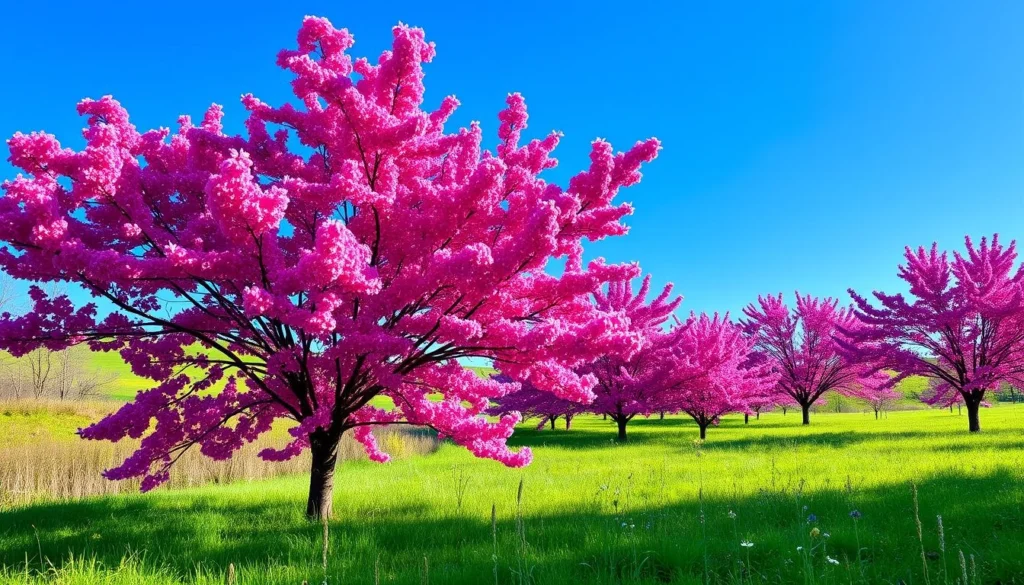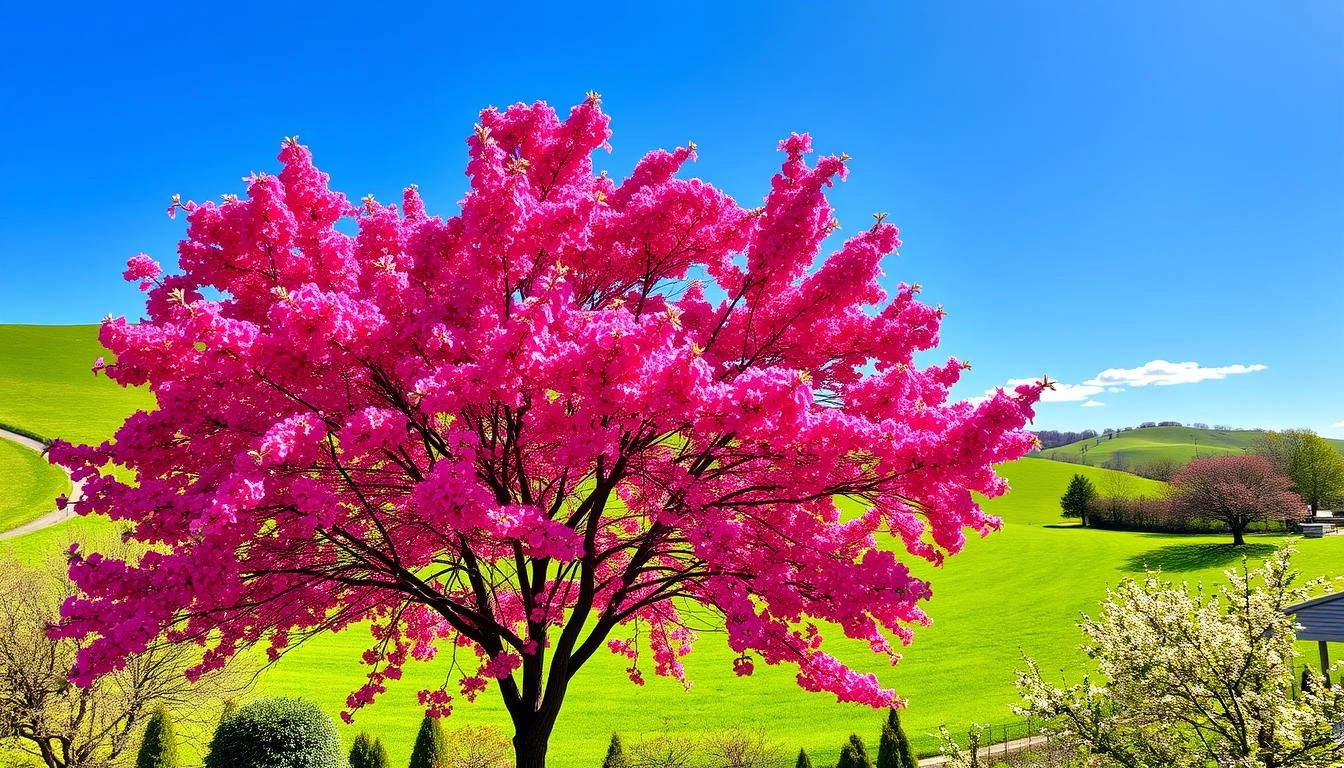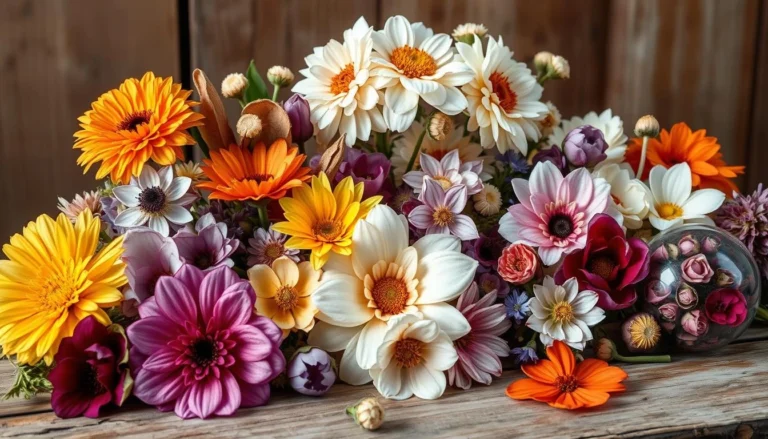“Redbud Trees: 7 Essential Secrets for Gorgeous, Thriving Blooms!”
Redbud trees, also known as Eastern Redbuds, are very popular in North America1. They are known for their beautiful blooms that range from pink to purple in spring1. If you want to add these stunning trees to your garden, this article has tips and techniques to help you.
Key Takeaways:
- Redbud trees (Cercis canadensis) are a beloved ornamental tree with vibrant spring blooms.
- These trees can grow up to 20-30 feet tall with a similar spread1.
- Redbuds prefer well-drained soil and do well in slightly acidic to neutral pH1.
- Proper pruning during dormancy is essential for maintaining the tree’s structure and air circulation1.
- Redbuds are moderately drought-tolerant but benefit from regular watering during dry spells1.
Choosing the Perfect Location for Your Redbud Tree
Choosing the right spot for your redbud tree is key to its success. These beautiful trees love well-drained soil with a pH between 6.0 and 7.02. They need 6-8 hours of sunlight a day and can handle some shade, but they grow best in full sun2. Make sure to keep them 10-15 feet away from other plants2.
Soil Requirements
Redbud trees can grow in many soils, like clay, loam, and sand3. But they do best in well-drained loamy or sandy soils2. It’s important to avoid wet, soggy conditions, as they don’t like it3.
Sunlight and Shade Needs
Twisted redbud trees do well in partial shade but love full sun2. They’re also great for urban areas, like parks and gardens2.
Spacing and Protection
Think about wind protection when planting a redbud tree2. Place it near natural barriers or create one to protect it from strong winds2. Also, plant them 10-15 feet apart from other plants2.
| Soil Type | pH Range | Sunlight Needs | Spacing |
|---|---|---|---|
| Well-drained loam or sandy | 6.0 – 7.0 | 6-8 hours of direct sunlight | 10-15 feet from other plants |
By considering soil, sunlight, and spacing, you can help your redbud tree thrive234.
“Redbuds are celebrated for their vibrant spring blooms and heart-shaped leaves, which offer a spectacular display in gardens and landscapes.”4
Planting Your Redbud Tree the Right Way
Planting a redbud tree needs careful planning and preparation. This ensures its health and beautiful blooms. Whether in spring or fall, the timing and methods used are crucial. Let’s look at the key steps to plant your redbud tree correctly.
Timing and Preparation
The best time to plant a redbud tree is in spring or fall. This is when the weather is mild, and the tree can grow its roots well without extreme temperatures5. Choose a spot where the soil drains well and gets 6-8 hours of sunlight daily5.
Hole Digging and Placement
Dig a hole that’s two to three times wider than the root ball but not deeper. This lets the roots spread and grow securely5. Place the tree in the hole, making sure the root ball is level with the soil. Then, fill the hole with the original soil, without changing it.
Mulching and Watering
After planting, add a 2-3 inch layer of organic mulch around the tree. Make sure it doesn’t touch the trunk5. This keeps moisture in and stops weeds5. Water the tree well, giving it about 15 gallons a week for the first few years to help it grow5.
By following these steps, your redbud tree will start strong and flourish for years. With the right planting, it will bloom beautifully in spring and have vibrant leaves56.
Comprehensive Care Guide for Redbud Trees
To keep your redbud tree healthy and beautiful, you need a good care plan. This includes pruning, watering, and managing pests. This guide will help your redbud tree thrive for many years.
Pruning Techniques
Pruning is key for shaping your redbud tree. The best time is in early spring, before new growth starts. Remove crowded branches and any dead or damaged limbs to improve air and sunlight.7
Watering Schedule
Redbud trees need regular watering, especially when they’re young. Water young trees once a week to keep the soil moist but not too wet.7 As they grow older, they need less water because they’re quite drought-tolerant8.
Pest and Disease Management
Redbuds can face pests and diseases like leaf spots and canker. Check your tree often for damage or infection and act quickly if you find any.7 You might need to use fungicides or insecticides, but keeping your tree healthy is the best defense8.
By following these care tips, your redbud tree will stay healthy and add beauty to your landscape for years.
Proper Pruning Methods for Optimal Growth
Pruning your redbud tree is key to keeping it healthy and looking good. You should cut off dead, damaged, or diseased branches. This makes the tree stronger and more attractive. Pruning helps your redbud tree grow well and look the way you want9.
Timing is everything when pruning redbud trees. The best time is late winter or early spring. This helps the tree heal quickly9. Young trees should be pruned in the dormant season for a strong start. Mature trees need pruning after they bloom9.
Using the right pruning techniques is important for a healthy tree. Focus on the branch collar and bark ridge for clean cuts and to avoid pests9. Pruning should help the tree grow better and stay healthy9.
Pruning young trees helps them grow strong from the start9. As trees get older, pruning keeps them healthy and strong. Removing dead or diseased branches is key to prevent disease9.
Nursery-grown redbud trees are often pruned a lot. This can slow down trunk thickening and taper growth in young trees10. Gardeners should consider these early pruning practices for their trees10.
Redbud trees bloom with beautiful flowers in early spring. Trimming them right helps prevent disease and structural issues11. Signs that a tree needs pruning include crossing branches, long branches, dead limbs, and a congested interior11.
When pruning, use the right tools like bypass pruners and loppers11. Avoid mistakes like topping, over-thinning, and cutting into old wood11.
The best time to trim redbud trees is when it doesn’t harm flowering, leafing, or dormancy11. Using the right pruning techniques helps the tree grow well and look good11910.
Enhancing Your Landscape with Redbud Trees
Redbud trees add a stunning touch to any garden. They bring vibrant blooms that turn your garden into a beautiful oasis. These trees are great for creating a peaceful mixed border, enhancing street planting, or attracting wildlife. They fit well into any landscape design12.
Companion Plants
Pair your redbud tree with flowering perennials and shrubs for a stunning look. Some great options include:
- Azaleas: Their bold, colorful blooms contrast beautifully with the redbud flowers.
- Echinacea: The vibrant pink and purple of these coneflowers match the redbud’s magenta.
- Hostas: Their lush foliage creates a serene backdrop for the redbud’s spring display.
- Daffodils: Their cheerful yellow flowers make a delightful combination with the redbud’s blossoms.
Design Ideas
Redbud trees are perfect for creative landscape designs. Plant one as a focal point to showcase its stunning flowers. Or, use it in a mixed border for depth and interest in your garden13.
For a formal look, plant redbuds as street trees. They also work well in a naturalistic woodland setting. This setting blends with native plants and helps local wildlife.

Redbud trees are a great choice for any landscape. They add beauty and ecological value to your outdoor space1213.
Redbud Varieties to Consider
The Eastern Redbud is well-known, but there are many other beautiful redbud trees to choose from. The Forest Pansy has vibrant purple leaves, while the Lavender Twist has graceful, cascading branches. Each variety brings something special to your garden14.
The Forest Pansy is a favorite for its purple leaves that change color with the seasons. It grows best in USDA Hardiness Zones 5 to 914.
The Lavender Twist is great for small spaces. It grows 4-10 feet tall and fits USDA Hardiness Zones 5 to 915.
The Texas Red Bud is perfect for hot climates. It grows best in USDA Hardiness Zone 614.
Looking for a tree with vibrant foliage, a weeping habit, or heat tolerance? There’s a redbud for every garden. By exploring these options, you can find the perfect tree to enhance your outdoor space.
Redbud Trees: A Stunning Addition to Any Garden
Redbud trees are a captivating choice for any landscape, offering a stunning display of colorful blooms and lush foliage16. They can be a focal point, part of mixed borders, or line streets and walkways. These trees bring natural elegance and charm to any outdoor space17. By choosing the right redbud variety, planting, and care, you can enjoy their vibrant blooms and heart-shaped leaves year after year.
The Rising Sun™ Redbud (Cercis Canadensis) is a standout option, known for its vibrant colors and iconic pink-lavender blooms16. This North Carolina native cultivar, discovered in Tennessee, features foliage that transitions from bright gold to orange and deep green. It’s a truly eye-catching addition to any landscape16. Its versatile growth habits and environmental benefits make it a popular choice among gardeners and landscapers.
Redbuds are relatively low maintenance due to their moderate size and non-intrusive roots, making them a versatile option for a variety of garden arrangements17. They can add color to your backyard, create a focal point along a walkway, or enhance your home’s curb appeal16. With their stunning foliage, practical uses, and historical significance, redbud trees are celebrated for their ornamental value, ability to attract pollinators, and environmental benefits, making them a desirable addition to any garden.
When selecting and caring for your redbud tree, it’s important to consider factors such as soil, sun exposure, and planting location17. The Rising Sun Redbud, for example, prefers full sun to partial shade, well-draining soil with a neutral to slightly acidic pH, and enough space to grow to 8-15 feet tall and wide16. By providing the right growing conditions and maintenance, you can ensure your redbud tree thrives and showcases its natural beauty for years to come.
| Redbud Tree Characteristics | Details |
|---|---|
| Family | Fabaceae (Pea and Legume Family) |
| Native Range | North America |
| Hardiness Zones | Eastern Redbuds: Zones 4-9, Western Redbuds: Zones 6-9 |
| Propagation Methods | Seed propagation and propagation by cuttings |
| Soil Requirements | Rich, well-drained soil |
| Sun Exposure | Full sun to partial shade |
| Mature Size | 20-30 feet tall, 15-25 feet wide |
| Fertilizer | Slow-release fertilizer, especially in spring |
| Pruning | Best done in late winter or spring after flowering |
Redbud trees can be an excellent addition to any garden, offering a vibrant and captivating presence throughout the seasons16. With their diverse growth habits, environmental benefits, and historical significance, these ornamental trees are a must-have for gardeners and landscapers looking to create a truly stunning outdoor space17.
“The Rising Sun Redbud is celebrated for its stunning foliage, practical uses, and historical significance, making it a desirable addition to any garden.”16
Frequently Asked Questions About Redbud Trees
Redbud trees are a favorite in many gardens. People often wonder how to care for these beautiful plants. Let’s look at some common questions about redbud trees and give you the answers you need to keep your tree healthy.
What are the different redbud tree varieties to consider?
The Eastern Redbud18 is a popular choice, growing 20-30 feet tall18. It has light pink to purple flowers18. The Oklahoma Redbud has vibrant magenta blooms18 and is good for dry areas18.
The Rising Sun Redbud is smaller, growing 6-10 feet tall18. The Forest Pansy has deep purple-red leaves19. The Royal White has striking white flowers19.
How do I care for a redbud tree?
Redbuds like well-drained soil and some shade, especially in the afternoon20. Remove grass around the tree and use wood mulch for best growth20. They can handle full sun but may struggle in coastal areas with salt20.
It’s important to water them regularly, especially when they’re young19. This helps them grow well in dry conditions19.
What pests and diseases should I be aware of?
Powdery mildew can be a problem, especially in wet places20. Leaf roller caterpillars might show up, but they won’t harm older trees20. Leaf cutter bees can also be seen, cutting circles in leaves for their nests20.
How long do redbud trees typically live?
Eastern Redbud trees usually live 20-30 years19. They grow fast, up to 24 inches a year19. They’re great for small spaces, growing 20-30 feet tall and 25-35 feet wide19.
Knowing how to care for redbud trees ensures they thrive. They bring beauty to your outdoor space for many years.
Protecting Your Redbud Tree from Wildlife
If you have a redbud tree, you’ll want it to stay healthy. Deer can harm these trees by eating the leaves21. To keep your redbud safe, try a few methods.
Putting up a strong fence around the tree is a good idea21. It keeps deer away from the leaves and branches. You can also use deer repellents around the tree21. These have smells or tastes that deer don’t like.
Planting deer-resistant plants around your redbud is another option21. Plants like lavender, daffodils, and sage can help keep deer away. This way, your redbud will stay safe and look beautiful for years.
| Deer Protection Method | Effectiveness | Maintenance |
|---|---|---|
| Fencing | High | Moderate |
| Deer Repellents | Moderate | High |
| Deer-Resistant Companion Plants | Moderate | Low |
Using a mix of these methods can protect your redbud tree well21. This way, your tree will stay healthy and bloom beautifully every spring21. With some effort, you can enjoy your tree’s beauty for many years.

“Protecting your trees from wildlife is a crucial aspect of maintaining a healthy and thriving landscape. By proactively addressing the needs of your redbud tree, you can ensure it continues to flourish and bring joy to your outdoor space.”
Redbud Trees
Growth Rate and Size
Redbud trees grow fast, reaching 20-30 feet tall and 25-35 feet wide in 10-15 years22. They thrive in USDA Hardiness Zones 4-9, fitting many climates23. Under the best conditions, they can grow a foot each year, making your yard lively and colorful.
Ideal Planting Time
Spring or fall is the best time to plant redbud trees23. These seasons help them grow strong roots and adjust to their new home. Plant them 6-8 feet apart to let them grow fully23. With the right care, your redbud trees will be a beautiful part of your outdoor area.
“Redbuds are a true harbinger of spring, lighting up the landscape with their vibrant, fuchsia-colored blooms.”
Conclusion
Redbud trees are a joy for any garden or landscape24. They offer beautiful spring blossoms and heart-shaped leaves. You can pick from the Eastern Redbud or other varieties like the Western Redbud, Chain Flowered Redbud, or Forest Pansy19. These trees will be a highlight in your outdoor area for many years.
This guide has all you need to know for planting and caring for redbud trees24. It helps your trees grow well and make your property look better. You’ll learn how to pick the best spot, plant them right, prune them, and keep them healthy.
So, why wait? Plant a redbud tree now and watch your landscape come alive with color19. These trees attract pollinators and add charm to your outdoor space. With proper care, they’ll become a favorite part of your garden, making your home look even better.







